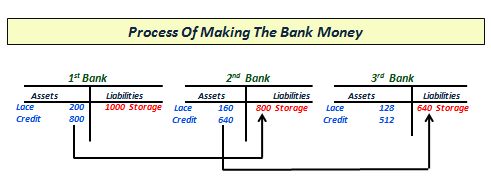MONETARY AGGREGATES AND BANK MONEY
Monetary Aggregates
When we speak about money, we usually refer
to the coins and notes in legal circulation. There are, however,
other modes that have more or less similar characteristics: value,
liquidity, mode of payment, etc.
When the Central bank tries to control the level
of liquidity (quantity of money) in the system, it analyses different
monetary aggregates according to the included concepts.
The most used aggregates, classified with more
or less aptitude are:
Cash in the public's hands (M0):
Currency (coins and notes) in legal circulation.
M1: currency in circulation
+ checkable deposits. M1 represents the assets that strictly
conform to the definition of money.
M2: M1 + saving deposits
in credit branches.
M3: M2 + large time
deposits and other money-market funds.
Liquid shares in the public's
hands (ALP): M3 + other components.
Bank Money
The financial entities (banks, savings banks,
etc) receive deposits from their clients into their acounts (which
is called bank money). This branches use these deposits to grant
credit.
For example: if a bank receives a
10.000 euros deposit from a client, part of this money will
be left in the bank to cover withdrawals (let's suppose that
this quantity is 1.000 euros). The rest of the money will go
towards credits (9.000 euros).
Part of the income of these credits returns
to the financial entities in the form of new bank deposits.
For example: a company that receives
a credit of 9.000 euros uses the money to buy a piece of machinery.
The seller receives the money from the sale and deposits the
money into his current account.
The bank that works with this seller
receives a new deposit of 9.000 euros and as we have already
seen in the previous example, they will leave a part of this
money in the bank (for example, 800 euros) and they will use
the rest (8,200 euros) to give out new credits.
We see that an initial deposit of 10.000 euros
has started a mechanism that means that the total sum of deposits
equals 19.000 euros (the inital 10.000 and the 9.000 which we
have just seen). And the process continues.
In short, banks multiply the value of their
deposits (they create bank money).
The commercial bank
transforms the deposits into a much larger quantity of bank money.

How much bank money
can be created?
To answer this question, we will start by defining
the concept of "mandatory bank reserve".
When financial organisatons receive
a deposit, they have to ensure a certain percentage of the amount
is accessible for withdrawls. This percentage is the "mandatory
bank reserve".
The Central Bank determines this
percentage, that is to say, they determine the amount the banks
have to have available in liquid form from the public's deposits
so that people do not have a problem when they want to withdraw
money.
The total amount of bank money generated by
the banks is determined by the "bank money multiplicator".
Bank money multiplicator
= 1 / Mandatory bank reserve
Let's continue with the example:
Let's suppose that in the case that
we have been analysing, the mandatory bank reserve is 10%. Therefore,
the bank money multiplicator will be:
Bank
money multiplicator = 1 / 0,10 = 10
Therefore, the banks will be able
to generate 10 times more bank money compared to the deposits
that they receive: if the initial deposit is 10.000 euros, the
bank money that they can generate is 100.000 euros.
This will be the maximum potential
sum of bank money that can be generated, what this does not
mean is that the bank will employ the whole amount available
in the credit concession, the credits may not return as deposits
in banks, etc.

